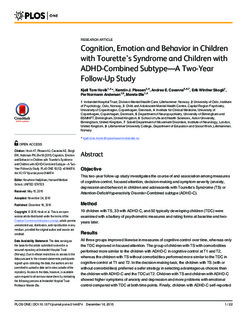Cognition, Emotion and Behavior in Children with Tourette’s Syndrome and Children with ADHD-Combined Subtype—A Two-Year Follow-Up Study
Hovik, Kjell Tore; Plessen, Kerstin J.; Cavanna, Andrea E.; Skogli, Erik Winther; Andersen, Per Normann; Øie, Merete
Peer reviewed, Journal article
Permanent lenke
http://hdl.handle.net/11250/2414110Utgivelsesdato
2015Metadata
Vis full innførselSamlinger
Originalversjon
doi:10.1371/journal.pone.0144874Sammendrag
Objective
This two-year follow-up study investigates the course of and association among measures
of cognitive control, focused attention, decision-making and symptom severity (anxiety,
depression and behavior) in children and adolescents with Tourette’s Syndrome (TS) or
Attention-Deficit/Hyperactivity Disorder-Combined subtype (ADHD-C).
Method
19 children with TS, 33 with ADHD-C, and 50 typically developing children (TDC) were
examined with a battery of psychometric measures and rating forms at baseline and twoyears
later.
Results
All three groups improved likewise in measures of cognitive control over time, whereas only
the TDC improved in focused attention. The group of children with TS with comorbidities
performed more similar to the children with ADHD-C in cognitive control at T1 and T2,
whereas the children with TS without comorbidities performed more similar to the TDC in
cognitive control at T1 and T2. In the decision-making task, the children with TS (with or
without comorbidities) preferred a safer strategy in selecting advantageous choices than
the children with ADHD-C and the TDC at T2. Children with TS and children with ADHD-C
showed higher symptoms of anxiety and depression and more problems with emotional
control compared with TDC at both time points. Finally, children with ADHD-C self-reported more depression symptoms than those with TS at both assessments. For the TS group,
safer decision-making was related to better emotional control, and this relationship was
stronger for the TS subgroup without comorbidities.
Conclusion
This study emphasizes the importance of addressing symptoms of anxiety and depression
in children with TS or ADHD-C, identifying the effect of comorbidities in children with TS,
and that children with TS or ADHD-C likely differ in their sensitivity to reinforcement
contingencies.

